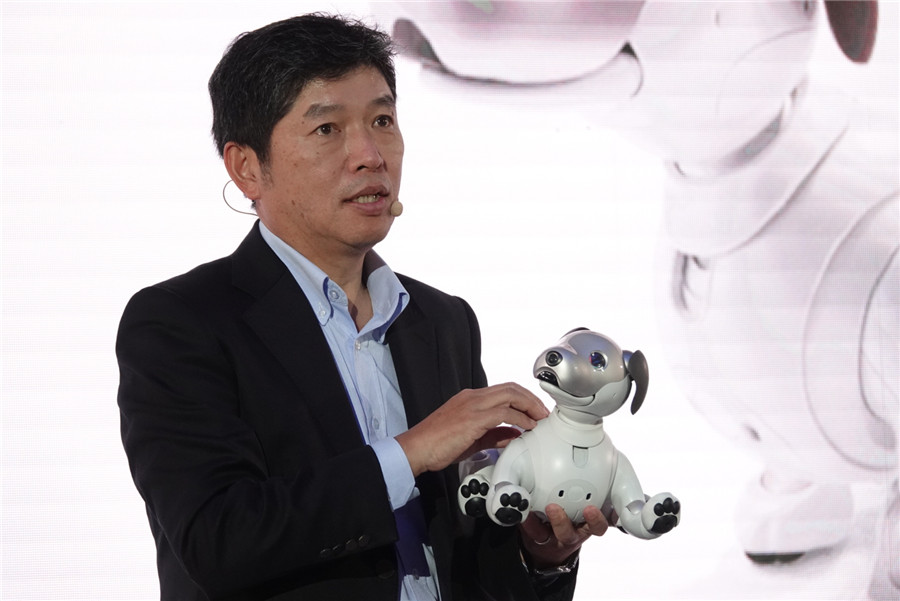Aiming at mobile market again
By Fan Feifei | China Daily | Updated: 2019-06-10 11:47

Sony's China arm, led by Hiroshi Takahashi, readies for a big push in smartphones
If you are meeting Hiroshi Takahashi, chairman and president of Sony China Ltd, for the first time, the Japanese corporate luminary can surprise you with his fluent Chinese. But, given his working experience in China, it should come as no surprise.
Takahashi is into his third stint in China. In 1979, he first came to China to study Mandarin. After graduating from Beijing Language and Culture University in 1985, he joined Japanese tech giant Sony Corporation.
From 1994, he worked with Sony in China for six years, and helped set up the local arm. He returned to China in 2016 to serve as chairman and president of Sony China.
Takahashi tracked China's momentous changes in the past 40 years although he was posted in the United States, Indonesia and Mexico during the period. For him, innovative business models and outlandish technologies that originated in China hold great fascination.
At present, China is one of Sony's largest single markets along with Japan and the US. The company's various businesses in China grew 12.7 percent in the first three quarters of the fiscal year 2018, according to Takahashi.
He said innovation has been integral to Sony's evolution over the decades. Sony's "black technology" that marks its screen displays is a shining example.
"With stable economic growth, emphasis on high-quality development and diversified consumption upgrade, China is increasingly becoming one of the most important strategic markets for Sony," said Takahashi, adding he has great confidence in the growth potential of the Chinese market.
He emphasized Sony won't give up its smartphone business. "The fifth-generation, or 5G, mobile communications technology is a trend, and will have an impact on any audio and video products. We attach huge importance to the development of 5G."
The company is working together with the Chinese authorities concerned and participating in the establishment of standards for the 5G-related high-capacity content transmission technology.
Sony faces intense rivalry in the smartphone segment from lowprice handsets as well as premium devices. The company will intensify efforts to revitalize the mobile phone business, he said.
Takahashi said Sony will soon launch its flagship smartphone sub-brand Xperia 1 in the China market. The model was unveiled at the MWC Barcelona (an event that was earlier called the Mobile World Congress) in February.
The Xperia 1 features 6.5-inch 4K HDR OLED display with 21:9 aspect ratio and 1644X3840 pixels resolution, ideal for watching movies. It is also the first Sony flagship phone to feature three rear cameras.
Takahashi said: "We will intensify efforts to revive the Sony smartphone, and our mobile business is expected to gain profits in 2020. Our basic business strategy is that each business segment assumes sole responsibility for its profits or losses.
"I'm confident of revitalizing Sony's mobile phone business in China, but it will still take several years to catch up with the rivals."
Although Sony's mobile phone business continues to hemorrhage cash, its other business lines are thriving. So, it has begun merging its mobile phone division with its television, audio and camera segments. The resulting combination will be known as the "electronic products and solutions division".
He underlined that Sony will not "hide" smartphone losses in the new division. Sony shut down a smartphone factory in Beijing at the end of March as it seeks to cut losses from its mobile division.
In recent years, Sony has been committed to providing premium products and services to meet various and increasingly sophisticated needs of Chinese consumers, hoping to seize the opportunity of quality and diversified consumer demand.
"The key to being recognized and supported by consumers and the market lies in our solid hardware base, including image sensors, lenses, processing chips, and other black technologies," he said.
Sony plans to expand its entertainment, gaming, music and animation businesses in China. Its gaming business entered China four years ago. Takahashi said Sony hopes to help Chinese developers in building more games and promote Chinese game culture across the world.
It has also launched a music streaming service on the Chinese mainland. As for animation, the company will strengthen the copyright business and try to develop local intellectual property or IP in China.
In February, Sony Corporation reported financial results for the third quarter of 2018. Its operating income came in at 377 billion yen ($3.3 billion), up 7 percent year-on-year.
"Sony's smartphones have an advantage in their camera functions, which can help expand the brand influence and reputation in China, strengthen the user experience and after-sales service, all of which should help attract a wide range of consumers," said Zhao Xiaoma, executive director of China Insights Consultancy.
























